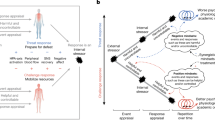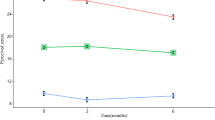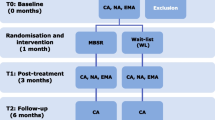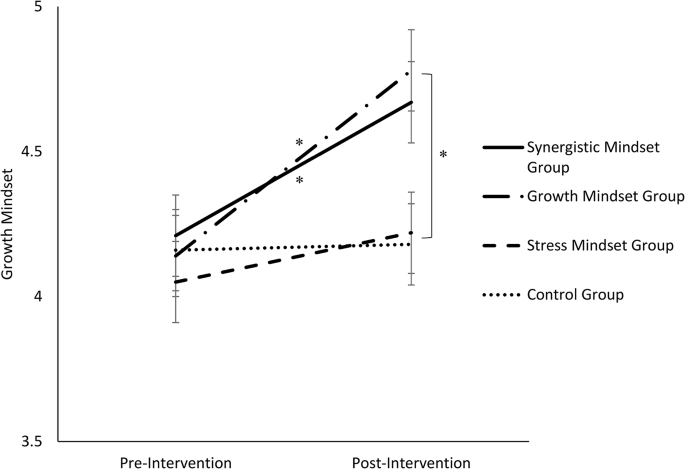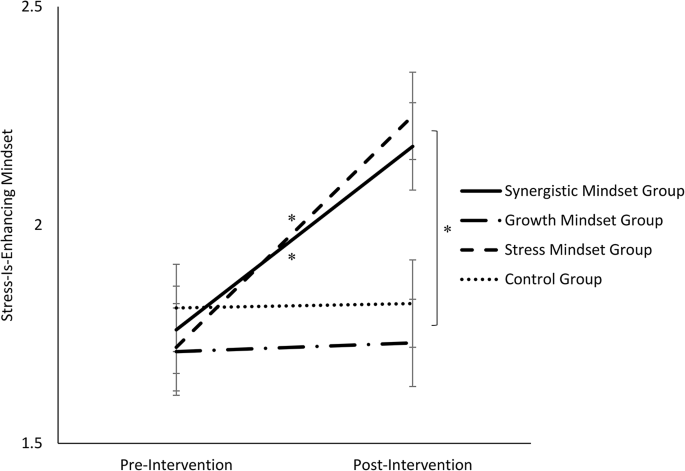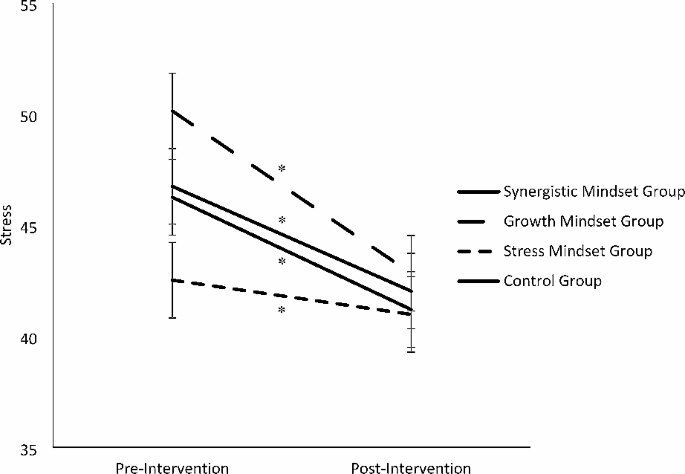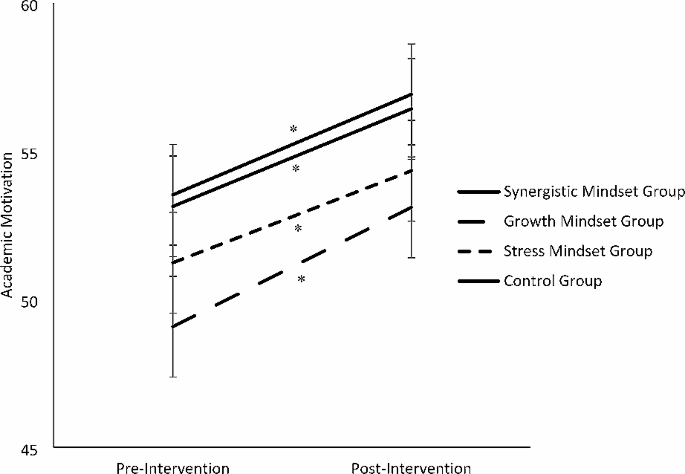Abstract
Stress levels are high among college students in the United States. Growth mindset and stress-is-enhancing mindset interventions offer ways to reduce stress, but minimal research has examined them. This study’s aim was to examine the effect of mindset interventions on mindsets, stress, academic motivation, and responses to hypothetical academic scenarios. Participants included 210 college students who were randomized to one of four groups: growth mindset (intelligence is malleable), stress mindset (stress is beneficial), synergistic (intelligence is malleable, and stress is beneficial), or control (brain functions). The growth mindset and the synergistic mindset group increased in growth mindset, and the growth mindset group had higher growth mindset than the stress mindset and control group post-intervention. The stress mindset and the synergistic group increased in stress-is-enhancing mindset, and both groups had higher stress-is-enhancing mindsets than the growth mindset and control group post-intervention. All groups decreased in stress and increased in academic motivation. The synergistic group was the only group to improve on all the main outcomes, and students in this group were less likely to want to withdraw from a course in both negative hypothetical academic scenarios (if they failed an assignment or were faced with a professor with a fixed mindset). Our findings suggest that students would benefit from increased access to mindset interventions.
Similar content being viewed by others
Avoid common mistakes on your manuscript.
The Effect of Mindset Interventions on Stress and Academic Motivation in College Students
The American College Health Association (2022) reported that approximately 50% of college students in the United States (U.S.) reported experiencing a moderate level of stress, and approximately 30% of students reported experiencing a high level of stress. Stress has been found to be strongly associated with psychological disorders (e.g., depression) and suicidality in college students (Liu et al., 2019). Therefore, it is critical to examine what factors are related to stress and how stress can be reduced.
One key factor that influences stress and resilience is one’s mindset (Yeager & Dweck, 2012). Mindsets are defined as one’s implicit theories about the flexibility of characteristics such as intelligence. There are two main types of mindsets regarding intelligence: growth and fixed (Dweck & Leggett, 1988). A growth mindset believes intelligence can be improved through effort, while a fixed mindset believes that intelligence is set and cannot change despite someone’s effort. Individuals are theorized to be on a continuum between these two mindsets. A meta-analysis found that growth mindsets are negatively correlated with psychological distress and positively correlated with active coping (Burnette et al., 2020). This association may be because a growth mindset buffers against maladaptive cognitions that can lead to maladaptive coping and/or adverse psychological outcomes.
A growth mindset is a skill that can be learned through interventions. For example, Smith and Capuzzi (2019) examined the effect of a single-session growth mindset intervention on anxiety and grades for U.S. college students in a statistics class (Smith & Capuzzi, 2019). They randomly assigned students to either a growth mindset intervention (e.g., a 75-minute interactive class session with exercises) or a control group (no intervention). They measured the students’ mindset and anxiety level at baseline and six months after completing the intervention. They found that students in the intervention group had an increased growth mindset, whereas mindset did not change in the control group. While they did not find significant changes in anxiety in either group, they found that a higher growth mindset was associated with lower anxiety and a higher course grade. Another study found that a single-session growth mindset intervention reduced depressive symptoms in U.S. adolescent girls four months after the intervention (Heaman et al., 2023).
Furthermore, a growth mindset is related to positive educational outcomes. A meta-analysis across 10 studies concluded that teaching students about a growth mindset increases their motivation and achievement (Sarrasin et al., 2018). For example, one study randomized adolescents in the U.S. to a growth mindset group (8-session intervention with information about the brain and growth mindset) or a control group (8-session intervention with information about the brain) (Blackwell et al., 2007). Students in the growth mindset group had significantly more positive change in classroom motivation three weeks after the intervention than the control group.
While a growth mindset is associated with lower stress (Burnette et al., 2020), two mindsets directly related to stress have been studied as well: stress-is-enhancing and stress-is-debilitating (Crum et al., 2013). A stress-is-enhancing mindset views stress as beneficial, whereas a stress-is-debilitating mindset views stress as harmful (Crum et al., 2013). Similar to growth and fixed mindsets, individuals are thought to be on a continuum between these two mindsets. Keech et al. (2018) found that having a stress-is-enhancing mindset was negatively correlated with perceived stress and was positively correlated with proactive behavior. Another study found that a stress-is-enhancing mindset served as a moderator between perceived stress and depressive symptoms in U.S. college students (Huebschmann & Sheets, 2020). The stress mindset is theorized to be beneficial in part because it changes how one psychologically experiences stress and how one behaviorally copes with stress (Crum et al., 2013).
Similar to a growth mindset, a stress-is-enhancing mindset can be developed through interventions. For example, one study with Australian university students found significant benefits of a stress mindset intervention (Keech et al., 2021). Students were randomized to one of two groups: an intervention group who watched videos about the consequences and benefits of stress and completed mental imagery tasks applying the benefits of stress in their own lives (one session of an unspecified length of time), or a control group who completed a mental imagery task unrelated to reframing stress. Two weeks after the intervention, the intervention group increased in stress-is-enhancing mindset from pre- to post-intervention and had a higher stress-is-enhancing mindset than the control group. In participants with high perceived stress, those in the intervention group also had lower distress and more proactive behavior than the control group. Another study using college students in the U.K. found that short videos about the stress-is-enhancing mindset was effective in increasing the stress-is-enhancing mindset immediately after the intervention (Williams & Ginty, 2023). However, no previous studies to our knowledge have examined the effect of a stress-is-enhancing intervention on academic motivation.
Yeager et al. (2022) proposed a mindset that combines the growth mindset and stress-is-enhancing mindset, which they called a synergistic mindset. They created a single-session 30-minute online module that contained information and exercises related to improving both mindsets. In a sample of U.S. college students, they found that this synergistic mindset intervention was more effective than a growth mindset intervention alone, a stress-is-enhancing mindset intervention alone, or a control intervention (learned about brain functions) in reducing cardiovascular reactivity when experiencing a social stressor shortly after the intervention (Yeager et al., 2022). In another sample of college students who received the intervention, they found that students made less negative stress appraisals about a quiz one to three days after the intervention and three weeks afterward (Yeager et al., 2022).
Having single-session interventions can be valuable as they are time- and cost-effective, but it’s important that they have lasting effects. A meta-analysis on single-session interventions on psychiatric problems in adolescents found that the interventions had the highest effect size for lasting effects on anxiety, which is similar to the present study’s focus on stress in young adults (Schleider & Weisz, 2017). Another study specifically examined the longitudinal effects of a single-session synergistic mindset intervention (Hecht et al., 2023). At the beginning of the semester, U.S. college students were randomly assigned to receive a 30-minute synergistic mindset or a control intervention (lesson about the brain). Subsequently, half of the students in each group received four 5-minute supportive messages related to the synergistic mindset whereas the other half received 5-minute neutral messages about assessing their learning progress periodically over the remainder of the semester (15-week semester). They found that the synergistic mindset intervention was effective in reducing fixed mindset beliefs and increasing stress-is-enhancing beliefs immediately after the intervention and at 3-weeks post-intervention similar to previous findings (Yeager et al., 2022); however, they found that receiving brief continued supportive messages made the initial intervention’s effects stronger over time (Hecht et al., 2023). Overall, single-session interventions are promising low-cost, accessible options that need further exploration.
Present Study
The present study is novel in two main ways. First, we examined the impact of mindset interventions on academic motivation and on responses to hypothetical academic scenarios to examine how mindsets could affect one’s potential behaviors, which has not been explored previously to our knowledge. Second, we assessed the efficacy of a shorter and simpler intervention (5 to 10 min) than was used previously (Yeager et al., 2022), which could make the intervention even more accessible for students.
Our main study aim was to assess the effect of mindset interventions on growth mindset, stress-is-enhancing mindset, stress, and academic motivation. We randomly assigned participants to one of four groups: growth mindset, stress mindset, synergistic mindset, or control. Participants’ growth mindset, stress-is-enhancing mindset, stress, and academic motivation were measured before and after the intervention. We hypothesized that the synergistic group would have increased growth mindset, stress-is-enhancing mindset, and academic motivation, and decreased stress from pre- to post-intervention. We also predicted that the synergistic group would have lower stress and higher academic motivation post-intervention compared to the other groups. In contrast, we predicted that the control group would have lower growth mindset, stress-is-enhancing mindset, and academic motivation and higher stress compared to the other groups post-intervention. Our second aim was to assess the effect of mindset interventions on responses to hypothetical academic scenarios to examine how mindsets could affect one’s potential behaviors. We did not create hypotheses for the second aim as it was exploratory.
Method
Participants
Any currently enrolled students at a southeastern college who were at least 18 years of age were eligible to participate in the study. According to a G*power analysis using an effect size f2 of 0.25, a power level of 0.80, and a significance value of 0.05, 136 participants were required for the main analysis (2 × 4 mixed ANOVA) to have sufficient statistical power (Faul et al., 2009). Although 272 participants began the survey and provided consent, we removed data from 62 participants because they stopped the study before finishing the pre-post measures (n = 58), or they did not follow the instructions in their written responses (n = 4). The majority of individuals who stopped early quit on the first survey (n = 26) or during the intervention (n = 21). There was not a clear trend that one intervention resulted in more drop-out than others (n = 4 growth mindset; n = 4 synergistic; n = 6 stress-is-enhancing mindset; n = 7 control group. Our final sample contained 210 participants, which was sufficient for our analyses.
Procedure
We received approval from the Institutional Review Board of the college and collected data in January 2023 online. Participants were recruited through a campus-wide email. After indicating consent, participants completed a baseline stress scale. Next, they completed measures of growth mindset, stress-is-enhancing mindset, state stress, and academic motivation. Subsequently, they were randomly assigned to one of four groups: growth mindset, stress mindset, synergistic mindset, or control. All groups completed three activities designed to shift their mindset to the group they were assigned. After completing the activities, participants completed the same assessments of growth mindset, stress-is-enhancing mindset, state stress, and academic motivation. Subsequently, participants responded to behavioral questions about hypothetical academic scenarios. Finally, participants completed demographic information. The study took approximately 17 min, and each participant was compensated with a $10 Amazon gift card.
Group Interventions
Our interventions were modeled after Yeager et al. (2022) but were adapted to be shorter and simpler. Each group first read research on their assigned mindset. The growth mindset group read about the malleability of the brain. The stress mindset group read about the adaptive purposes of stress. The synergistic mindset group read about both of those topics, and the control group read about the functional areas of the brain. Each group then read practical strategies about how to implement the mindsets in their life. Next, participants read an example story about how a student applied the assigned mindset to an academic challenge. Finally, participants were asked to write a short paragraph about how they planned to use a similar mindset and strategies on a future academic setback/challenge. They were prompted to write at least 500 characters (100 words). Each group’s procedure is detailed in the Supplemental Materials.
Measures
Baseline Stress
Baseline stress was measured with the Perceived Stress Scale, which asked participants questions to rate their stress levels over the past month (Cohen et al., 1983). Participants rated 10 items (e.g., “In the last month, how often have you been upset because of something that happened unexpectedly?”) on a scale from 0 (never) to 4 (very often). After reverse scoring the necessary items, a total score was calculated. The possible total score ranged from 0 to 40, with higher scores representing more stress. Cronbach’s α was 0.86.
Pre-Post Measures
Growth Mindset
The Growth Mindset Scale assessed whether participants believe they can learn and improve (Dweck et al., 1995). Participants indicated their agreement with three items (e.g., “You have a certain amount of intelligence, and you can’t really change it”) on a Likert scale from 1 (strongly agree) to 6 (strongly disagree). Items were reverse-scored and averaged; higher scores indicated a higher growth mindset. Cronbach’s α was 0.88 for pre- and post-intervention.
Stress Mindset
The Stress Mindset Measure assessed whether participants view stress as enhancing or debilitating (Crum et al., 2013). Participants indicated their agreement to eight items (e.g., “Experiencing stress facilitates my learning and growth”) on a Likert scale from 0 (strongly disagree) to 4 (strongly agree). Scores were averaged, and higher scores indicated a higher stress-is-enhancing mindset. Cronbach’s α was 0.83 for pre-intervention and 0.88 for post-intervention.
State Stress
State stress was measured through a visual analog scale where participants indicated how much they felt stress currently from 0 (not at all) to 100 (extremely).
Academic Motivation
Academic motivation was measured through a visual analog scale where participants indicated how motivated they felt to complete their coursework currently from 0 (not at all) to 100 (extremely).
Academic Scenarios
Participants read and responded to three hypothetical academic scenarios. The first scenario involved failing an assignment: “Imagine you fail the first assignment of the semester after completing the work and trying your best.” The second scenario included a professor’s fixed mindset response: “Imagine that you talk to the professor about your failed assignment. Your professor tries to make you feel better by telling you that this subject is hard and isn’t for everyone.” The third scenario demonstrated a professor’s growth mindset response: “Imagine that you talk to the professor about your failed assignment. Your professor tries to make you feel better by telling you that they will help you, and they believe in your ability to improve.” In each scenario, participants were asked to rate how much they would want to withdraw from the course if they could on a visual analogue scale from 0 (not at all) to 100 (extremely).
Demographic Questions
Participants reported their age, gender, race, ethnicity, and class year.
Manipulation Check
We examined all the written responses to the interventions to make sure they followed instructions of their group assignment. We removed four individuals for not following those instructions.
Statistical Analyses
SPSS version 28 was used for all analyses. Descriptive statistics and reliability analyses were calculated for all main variables. Chi-squared analyses were conducted to assess if there were differences in demographic variables among the four groups. A one-way (group) ANOVA was conducted for baseline stress to determine any baseline differences among the four groups. For aim 1, we conducted 2 (time) x 4 (group) mixed ANOVAs on growth-mindset, stress-is-enhancing mindset, stress, and academic motivation. For aim 2, we conducted one-way between-subjects (4 groups) ANOVAs on desire to withdraw from a course based on three hypothetical scenarios. Post-hoc tests using Bonferroni were conducted to determine where the significant differences occurred.
Results
Descriptive Statistics of Participants
Descriptive statistics including gender, race, ethnicity, class year, and age for participants are displayed in Table 1. Most participants were White, non-Hispanic/Latinx women. The mean age of participants was 20 years old and ranged from 18 to 22. There were no significant differences by demographic variables among the four groups (Table 1).
Aim 1
Growth Mindset
There was a significant interaction between time and group for growth mindset, F(3, 206) = 10.65, p < .001, ηp2 = 0.13 (Fig. 1). Growth mindset significantly increased from pre-intervention (M = 4.21, SD = 1.05) to post-intervention (M = 4.67, SD = 1.06) in the synergistic group, p < .001. Additionally, growth mindset significantly increased from pre-intervention (M = 4.14, SD = 1.05) to post-intervention (M = 4.78, SD = 1.07) in the growth mindset group, p < .001. At post-intervention, the growth mindset group (M = 4.78, SD = 1.07) had significantly higher growth mindset than the control group (M = 4.18, SD = 1.06), p = .028, and the stress mindset group (M = 4.22, SD = 1.06), p = .048.
Stress-is-Enhancing Mindset
There was a significant interaction between time and group for stress-is-enhancing mindset, F(3, 206) = 17.74, p < .001, ηp2 = 0.21 (Fig. 2). Stress-is-enhancing mindset significantly increased from pre-intervention (M = 1.76, SD = 0.67) to post-intervention (M = 2.18, SD = 0.66) in the synergistic group, p < .001. Additionally, stress-is-enhancing mindset significantly increased from pre-intervention (M = 1.72, SD = 0.65) to post-intervention (M = 2.25, SD = 0.63) in the stress mindset group, p < .001. At post-intervention, the synergistic group (M = 2.18, SD = 0.69) had significantly higher stress-is-enhancing mindset than the control group (M = 1.82, SD = 0.69), p = .048, and the growth mindset group (M = 1.73, SD = 0.69), p = .005. Also at post-intervention, the stress mindset group (M = 2.25, SD = 0.69) had significantly higher stress-is-enhancing mindset than the control group (M = 1.82, SD = 0.69), p = .011, and the growth mindset group (M = 1.73, SD = 0.69), p < .001.
Stress
There was a significant main effect by time, F(1, 206) = 21.80, p < .001, ηp2 = 0.10, such that stress decreased across all groups from pre-exposure (M = 46.41, SD = 23.59) to post-exposure (M = 41.76, SD = 25.04), p < .001 (Fig. 3). However, there was not a significant main effect by group, F(3, 206) = 0.37, p = .77, ηp2 = 0.005, or a significant interaction by time and group, F(3, 206) = 1.42, p = .24, ηp2 = 0.02.
Academic Motivation
There was a significant main effect by time, F(1, 206) = 13.74, p < .001, ηp2 = 0.063, such that academic motivation increased across all groups from pre-exposure (M = 51.74, SD = 25.94) to post-exposure (M = 55.19, SD = 25.98) (Fig. 4). However, there was not a significant main effect by group, F(3, 206) = 0.31, p = .82, ηp2 = 0.004, or a significant interaction by time and group, F(3, 206) = 0.05, p = .99, ηp2 = 0.001.
Aim 2
There was a significant main effect for group about wanting to withdraw from a course if they could when they failed the first assignment after trying their best, F(3, 206) = 5.99, p < .001, ηp2 = 0.08. The synergistic group (M = 40.54, SD = 33.60) had a significantly lower likelihood of wanting to withdraw from the course compared to the control group (M = 67.15, SD = 33.59), p < .001. In addition, the stress mindset group (M = 46.22, SD = 33.64) had a significantly lower likelihood of wanting to withdraw from the course compared to the control group (M = 67.15, SD = 33.59), p = .01.
There was also a significant main effect for group about wanting to withdraw when participants were faced with a professor with a fixed mindset, F(3, 206) = 2.88, p = .037, ηp2 = 0.04. Participants in the synergistic group (M = 51.37, SD = 35.52) were significantly less likely to want to withdraw from the course than those in the control group (M = 71.48, SD = 35.57), p = .03. When a professor had a growth mindset, participants did not differ significantly in their likelihood to want to withdraw from the course based on their mindset group, F(3, 206) = 1.08, p = .36, ηp2 = 0.02.
Discussion
This study’s main aim was to examine the effect of mindset interventions on mindsets, state stress, and academic motivation. Our hypotheses were partially supported. Each mindset intervention improved mindsets as intended. In addition, state stress decreased, and academic motivation increased from pre- to post-intervention in the mindset groups as predicted, but we did not predict that state stress would decrease and academic motivation would increase in the control group as well. In addition, we did not find that the synergistic group had better outcomes compared to the other three groups for stress and academic motivation. The study’s second aim was to examine the effect of the mindset interventions on hypothetical academic scenarios. We found that students in the synergistic group were the only students who were less likely to want to withdraw from a course in both negative hypothetical academic scenarios (if they failed an assignment or were faced with a professor with a fixed mindset), suggesting the benefits of the synergistic mindset.
Our results showed that the growth mindset intervention (in both the growth mindset group and synergistic group) was successful in increasing a growth mindset. This finding aligns with previous research (Smith & Capuzzi, 2019). However, our study also found that the growth mindset intervention reduced stress, whereas Smith and Capuzzi (2019) did not find a change in anxiety, though they found a negative relationship between growth mindset and anxiety. Perhaps the difference in the construct of anxiety versus stress and the different measures used in those studies played a role in those varying results. However, our study’s intervention was notably shorter (5 to 10 min) than Smith and Capuzzi’s (2019) 75-minute intervention, which suggests that a growth mindset can be induced more efficiently. Moreover, we found that the growth mindset intervention increased academic motivation, which parallels previous research (Blackwell et al., 2007; Sarrasin et al., 2018). That said, it is important to note that while participants in the growth mindset group had significantly higher growth mindset than the control group, there were not differences between the groups for stress and academic motivation, indicating a lack of treatment effect for those variables. That lack of difference may be because those variables were more distal outcomes. A meta-analysis found that the largest effects for growth mindset interventions are on more proximal outcomes such as mindset than more distal outcomes such as psychological health (Burnette et al., 2023).
Similarly, we found that the stress mindset intervention (in both the stress mindset group and synergistic group) was successful in increasing a stress-is-enhancing mindset. This finding is in concert with previous research (Keech et al., 2021). Furthermore, we found that stress decreased in those groups, whereas Keech et al. (2021) only found decreased stress in participants who had overall higher stress than the other participants. Our sample had high averages of baseline stress across all groups, which may be why we found an overall difference for everyone. We also found that the stress mindset intervention increased academic motivation, which has not been studied previously to our knowledge. Perhaps rethinking academic stress reminded students of the benefits of learning rather than viewing it as threatening, which may have led to an increased desire to complete academic work. However, similar to growth mindset, we only found differences between the stress mindset group and the control group for the proximal outcome of stress-is-enhancing mindset, which indicates there was not a treatment effect for stress and academic motivation.
The control group did not change in growth mindset or stress-is-enhancing mindset over time, which aligns with expectations. Surprisingly, though, the control group had decreased stress and increased academic motivation after learning about the brain, despite us using a similar control group design as Yeager et al. (2022). It is possible that learning about the function of different brain parts and writing about them led to increased feelings of appreciation of one’s brain. Completing this activity also served as a break from their academic work, which may also have led to students feeling less stressed and more energized for their work.
While the synergistic group was the only group to have improvements in all four outcomes, the synergistic group did not show significantly better results in stress reduction and academic motivation than the other groups. Therefore, it appears that learning about both mindsets does not necessarily have additive effects as they potentially affect stress and academic motivation in a similar way. However, the mechanisms of how those mindsets are related to different outcomes needs to be explored further.
For our second aim, we found that the interventions affected projected behavioral responses to hypothetical academic scenarios. The synergistic and stress mindset groups were significantly less likely to want to withdraw from a course compared to the control group when faced with failing the first assignment in a course after trying their best. Perhaps they were applying what they learned and practiced in the intervention to view the failure as a challenge rather than a stressor.
In addition, participants in the synergistic group were less likely to want to withdraw from a course compared to the control group when faced with a professor who expressed a fixed mindset. This finding is in line with previous research that shows that a professor’s mindset can affect students’ course engagement and dropout intentions (Muenks et al., 2020). The synergistic group may have applied both ideas from the growth mindset and stress mindset intervention; they may have trusted their own mindset rather than the professor’s mindset and reframed the situation as a challenge rather than a stressor. These behavioral responses suggest that the synergistic group may confer benefits above and beyond the single mindset groups.
Our sample had multiple limitations regarding participants. For example, the sample was mostly white, educated women, which limits the generalizability of our findings. The demographics of this study’s sample also could have influenced the familiarity of participants with the concepts taught. For example, the concept of a growth mindset is now commonly taught in many college courses, especially psychology courses. Therefore, participants may have already been aware of some of the research about mindsets.
Furthermore, the intervention was limited in several ways. We do not know if participants read and absorbed each piece of information. In addition, twenty-one participants quit the study during the intervention, which could indicate that they were not interested in it or engaged with it. There was not a clear difference in drop-out across intervention groups, so it’s possible it was due to all of them requiring writing. However, further research is needed to determine why some individuals would choose not to continue this type of intervention. A few individuals also had negative responses to the stress mindset intervention as they thought that it was invalidating to the negative impact of stressors. Yeager et al. (2022) highlighted that mindset interventions are not meant for reappraising traumatic stressors; therefore, it’s possible that the individuals who had a negative response may have had those types of experiences and felt invalidated. In turn, feeling emotionally invalidated has been found to predict negative affect and stress (Schreiber & Veilleux, 2022; Zielinski et al., 2023). Recent research has discovered that applying a meta-cognitive approach that highlights both the stress-is-enhancing mindset and addresses how to handle society’s messaging around the negative aspects of stress was more effective than a stress-is-enhancing mindset intervention alone (Crum et al., 2023). Future research should continue to explore how these interventions can balance providing the benefit of mindset change while not invalidating an individual’s stress.
Moreover, there were limitations to our measures and the timing of them. State stress and academic motivation were single item sliders, which did not allow us to assess reliability. We also administered the intervention at the beginning of the semester, which could have influenced engagement and perceived relevance of the information. Furthermore, since we only assessed participants at one time point, we do not know how long the effects of the short intervention lasted. While single-session mindset interventions have been shown to have long-term effects (e.g., Heaman et al., 2023; Hecht et al., 2023; Smith & Capuzzi, 2019), it is possible that this shorter intervention will not have sustained effects over time. Including brief “booster” sessions after the intervention similar to Hecht et al. (2023) would potentially be valuable and should be examined in future research.
The main implication of our study is that brief mindset interventions can be effective in shifting student mindsets. Our results also showed that the synergistic mindset intervention provided the most benefits to students; it was the only group that improved on all the main outcomes, and students in this group were less likely to want to withdraw from a course in both negative hypothetical academic scenarios (if they failed an assignment or were faced with a professor with a fixed mindset). This type of brief (5–10 min) mindset intervention could be easily applied online by students or led by teachers in the classroom. Future research should further examine the mechanisms by which these mindsets are effective on various outcomes. In addition, research should examine the longitudinal effects of brief interventions and if students apply them behaviorally. It also would be valuable for studies to examine how individuals’ characteristics (e.g., age, gender) influence the effectiveness of mindset interventions. Overall, continuing this research can have benefits on reducing stress and improving educational outcomes in young adults.
Data Availability
Data can be made available upon request.
References
American College Health Association (2022). National College Health Assessment: Spring 2022 reference group executive summary. https://www.acha.org/documents/ncha/NCHA-III_SPRING_2022_REFERENCE_GROUP_EXECUTIVE_SUMMARY.pdf
Blackwell, L. S., Trzesniewski, K. H., & Dweck, C. S. (2007). Implicit theories of intelligence predict achievement across an adolescent transition: A longitudinal study and an intervention. Child Development, 78(1), 246–263. https://doi.org/10.1111/j.1467-8624.2007.00995.x
Burnette, J. L., Knouse, L. E., Vavra, D. T., O’Boyle, E., & Brooks, M. A. (2020). Growth mindsets and psychological distress: A meta-analysis. Clinical Psychology Review, 77, 101816. https://doi.org/10.1016/j.cpr.2020.101816
Burnette, J. L., Billingsley, J., Banks, G. C., Knouse, L. E., Hoyt, C. L., Pollack, J. M., & Simon, S. (2023). A systematic review and meta-analysis of growth mindset interventions: For whom, how, and why might such interventions work? Psychological Bulletin, 149(3–4), 174–205. https://doi.org/10.1037/bul0000368
Cohen, S., Kamarck, T., & Mermelstein, R. (1983). A global measure of perceived stress. Journal of Health and Social Behavior, 24(4), 385–396. https://doi.org/10.2307/2136404
Crum, A. J., Salovey, P., & Achor, S. (2013). Rethinking stress: The role of mindsets in determining the stress response. Journal of Personality and Social Psychology, 104(4), 716–733. https://doi.org/10.1037/a0031201
Crum, A. J., Santoro, E., Handley-Miner, I., Smith, E. N., Evans, K., Moraveji, N., Achor, S., & Salovey, P. (2023). Evaluation of the rethink stress mindset intervention: A metacognitive approach to changing mindsets. Journal of Experimental Psychology: General, 152(9), 2603–2622. https://doi.org/10.1037/xge0001396
Dweck, C. S., & Leggett, E. L. (1988). A social-cognitive approach to motivation and personality. Psychological Review, 95, 256–273. https://doi.org/10.1037/0033-295X.95.2.256
Dweck, C. S., Chiu, C., & Hong, Y. (1995). Implicit theories and their role in judgments and reactions: A world from two perspectives. Psychological Inquiry, 6(4), 267–285. https://doi.org/10.1207/s15327965pli0604_1
Faul, F., Erdfelder, E., Buchner, A., & Lang, A. G. (2009). Statistical power analyses using G*Power 3.1: Tests for correlation and regression analyses. Behavior Research Methods, 41(4), 1149–1160. https://doi.org/10.3758/BRM.41.4.1149
Heaman, J. A. L., Cherry, K. M., McMurtry, C. M., Giguère, B., & Lumley, M. N. (2023). Changing minds: An rct of a growth mindset intervention on depressive symptoms and well-being in adolescent girls and boys. International Journal of Applied Positive Psychology. https://doi.org/10.1007/s41042-023-00128-z
Hecht, C. A., Gosling, S. D., Bryan, C. J., Jamieson, J. P., Murray, J. S., & Yeager, D. S. (2023). When do the effects of single-session interventions persist? Testing the mindset + supportive context hypothesis in a longitudinal randomized trial. JCPP Advances, 3(4), e12191. https://doi.org/10.1002/jcv2.12191
Huebschmann, N. A., & Sheets, E. S. (2020). The right mindset: Stress mindset moderates the association between perceived stress and depressive symptoms. Anxiety Stress & Coping: An International Journal, 33(3), 248–255. https://doi.org/10.1080/10615806.2020.1736900
Keech, J. J., Hagger, M. S., O’Callaghan, F. V., & Hamilton, K. (2018). The influence of university students’ stress mindsets on health and performance outcomes. Annals of Behavioral Medicine, 52(12), 1046–1059. https://doi.org/10.1093/abm/kay008
Keech, J. J., Hagger, M. S., & Hamilton, K. (2021). Changing stress mindsets with a novel imagery intervention: A randomized controlled trial. Emotion, 21(1), 123–136. https://doi.org/10.1037/emo0000678.supp
Liu, C. H., Stevens, C., Wong, S. H. M., Yasui, M., & Chen, J. A. (2019). The prevalence and predictors of mental health diagnoses and suicide among U.S. college students: Implications for addressing disparities in service use. Depression and Anxiety, 36(1), 8–17. https://doi.org/10.1002/da.22830
Muenks, K., Canning, E. A., LaCosse, J., Green, D. J., Zirkel, S., Garcia, J. A., & Murphy, M. C. (2020). Does my professor think my ability can change? Students’ perceptions of their STEM professors’ mindset beliefs predict their psychological vulnerability, engagement, and performance in class. Journal of Experimental Psychology: General, 149(11), 2119–2144. https://doi.org/10.1037/xge0000763.supp
Sarrasin, J. B., Nenciovici, L., Foisy, L. M. B., Allaire-Duquette, G., Riopel, M., & Masson, S. (2018). Effects of teaching the concept of neuroplasticity to induce a growth mindset on motivation, achievement, and brain activity: A meta-analysis. Trends in Neuroscience and Education, 12, 22–31. https://doi.org/10.1016/j.tine.2018.07.003
Schleider, J. L., & Weisz, J. R. (2017). Little treatments, promising effects? Meta-analysis of single-session interventions for youth psychiatric problems. Journal of the American Academy of Child and Adolescent Psychiatry, 56(2), 107–115. https://doi.org/10.1016/j.jaac.2016.11.007
Schreiber, R. E., & Veilleux, J. C. (2022). Perceived invalidation of emotion uniquely predicts affective distress: Implications for the role of interpersonal factors in emotional experience. Personality and Individual Differences, 184, 111191. https://doi.org/10.1016/j.paid.2021.111191
Smith, T. F., & Capuzzi, G. (2019). Using a mindset intervention to reduce anxiety in the statistics classroom. Psychology Learning & Teaching, 18(3), 326–336. https://doi.org/10.1177/1475725719836641
Williams, S. E., & Ginty, A. T. (2023). Improving stress mindset through education and imagery. Anxiety Stress and Coping, 1–9. https://doi.org/10.1080/10615806.2023.2279663
Yeager, D. S., & Dweck, C. S. (2012). Mindsets that promote resilience: When students believe that personal characteristics can be developed. Educational Psychologist, 47(4), 302–314. https://doi.org/10.1080/00461520.2012.722805
Yeager, D. S., Bryan, C. J., Gross, J. J., Murray, J. S., Cobb, D. K., Santos, P. H. F., Gravelding, H., Johnson, M., & Jamieson, J. P. (2022). A synergistic mindsets intervention protects adolescents from stress. Nature, 607(7919), 512–520. https://doi.org/10.1038/s41586-022-04907-7
Zielinski, M. J., Veilleux, J. C., Fradley, M. F., & Skinner, K. D. (2023). Perceived emotion invalidation predicts daily affect and stressors. Anxiety Stress and Coping, 36(2), 214–228. https://doi.org/10.1080/10615806.2022.2033973
Funding
Open access funding provided by the Carolinas Consortium. This work was supported by the George L. Abernethy Endowment at Davidson College.
Author information
Authors and Affiliations
Contributions
Heidi Meyer and Lauren Stutts designed the study aims and procedures, obtained IRB approval, conducted literature searches, provided summaries of previous research studies, collected the data, analyzed the data, and wrote the paper. All authors have contributed to and approve the final manuscript.
Corresponding author
Ethics declarations
Financial Interests
The authors declare they have no financial interests.
Non-Financial Interests
None.
Research Involving Human Participants
This study was approved by the Institutional Review Board at Davidson College.
Informed Consent
All participants provided informed consent before they began the study.
Additional information
Publisher’s Note
Springer Nature remains neutral with regard to jurisdictional claims in published maps and institutional affiliations.
Electronic Supplementary Material
Below is the link to the electronic supplementary material.
Rights and permissions
Open Access This article is licensed under a Creative Commons Attribution 4.0 International License, which permits use, sharing, adaptation, distribution and reproduction in any medium or format, as long as you give appropriate credit to the original author(s) and the source, provide a link to the Creative Commons licence, and indicate if changes were made. The images or other third party material in this article are included in the article’s Creative Commons licence, unless indicated otherwise in a credit line to the material. If material is not included in the article’s Creative Commons licence and your intended use is not permitted by statutory regulation or exceeds the permitted use, you will need to obtain permission directly from the copyright holder. To view a copy of this licence, visit http://creativecommons.org/licenses/by/4.0/.
About this article
Cite this article
Meyer, H.H., Stutts, L.A. The Effect of Mindset Interventions on Stress and Academic Motivation in College Students. Innov High Educ (2024). https://doi.org/10.1007/s10755-024-09706-8
Accepted:
Published:
DOI: https://doi.org/10.1007/s10755-024-09706-8


